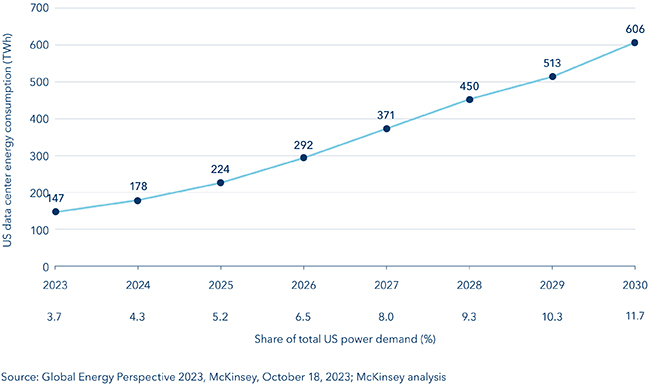The role of energy efficiency in modern data centres (guest article)
The growing hunger for energy in data centres
The renowned consulting firm McKinsey is forecasting a dramatic increase in electricity demand for data centres in the USA. This is expected to grow to an impressive 600 terawatt hours by 2030. To make the scale of this figure tangible: Switzerland as a whole consumes only a tenth of this, namely around 60 terawatt hours of electricity.
To put this into perspective, one terrawatt hour is equivalent to 1,000 gigawatt hours, 1,000,000 mega-watt hours or one billion kilowatt hours. This enormous increase is due to the increasing use of cloud services, artificial intelligence and the Internet of Things, all of which require considerable computing power.

Computing-intensive AI models and data processing
Artificial intelligence is a major driver of the rising energy demand. There are several reasons for this:
- Computing-intensive processes: AI models, especially in the field of machine learning and deep learning, require immense computing power. These models run through complex calculations and analyses in order to recognise patterns in large amounts of data and derive predictions or decisions from them.
- Exponential data requirements: AI systems are extremely data-hungry. Processing, storing and analysing large amounts of data, from image and video data to text and sensor data, consumes a lot of power, especially in data centres.
- Real-time and edge computing applications: AI applications such as autonomous driving, connected cities (smart cities) or the Internet of Things rely on real-time data processing, which often takes place at multiple locations and at high speed. This requires additional energy-intensive systems, such as edge computing devices, to analyse data in real time.
- Demand for ever larger models: With the race to develop more powerful AI systems, computing power requirements are also increasing. Advanced models such as ChatGPT or image generators (e.g. DALL-E) are growing in size and complexity, which further increases the energy requirements for training and deployment. These AI models consist of billions of parameters that need to be optimised during the training process. Training requires immense computing resources and can take weeks or even months, using specialised hardware such as GPUs and TPUs.
Sustainable solutions through AI
AI is being used successfully to promote sustainable solutions and efficient energy use, for example through smart grids and energy optimisation in industry. Smart grids are intelligent power grids that use AI to efficiently control and optimise the flow of energy. By analysing real-time data, smart grids can predict energy consumption and adjust the distribution of electricity accordingly. This enables better integration of renewable energy sources such as solar and wind power, which are naturally volatile.
Growth and challenges of data centres
To meet the increased demand, companies are expanding their data centres or moving workloads to the cloud, where huge server farms are operated. These data centres not only require energy to run the hardware, but also to cool the equipment.
Data centres that support AI systems must have efficient cooling systems to cope with the heat generated by the intensive computing work. This poses an additional challenge, as the cooling itself also consumes a lot of energy. The cooling of data centres is a decisive factor that not only contributes to security and performance, but also has a significant impact on energy efficiency, operating costs and the ecological balance of modern IT infrastructures.
Investments in data centre infrastructure
Investments in companies that develop technical solutions for data centre infrastructure are attractive. These companies are ideally positioned to benefit from the global digitalisation trend, sustainability goals and the increasing demand for high-performance data centre infrastructure. They offer investors the opportunity to invest in a stable, fast-growing and technologically innovative market.
Global Strategic Capital's strategy includes targeted investments in the following companies:
| Company | Expertise |
| ABB | Grid Connection |
| Alfa Laval | Thermal Technologies - Heat Recovery |
| Eaton | Power monitoring, security solutions (cyber risk) |
| Linde PLC | Back up power (Hydrogen) |
| Schneider Electric | Hardware - Modular Solutions |
| Stantec | Data center design |
| Trante Technologies | Operations - HVAC management |
| Quanta Services | Immersion cooling |
Conclusion
Data centres are the backbone of digital transformation by providing the necessary computing power for cloud services, AI or IoT applications. With the increasing demand for data processing, cloud storage and digital networking, the need for energy-efficient solutions is also growing. Companies that develop technologies to optimise energy consumption and improve the efficiency of data centres will be increasingly in demand. These developments not only offer economic opportunities, but also contribute to reducing the ecological footprint.